 |
 |
 |
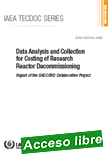 |
Data Analysis and Collection for Costing of Research Reactor Decommissioning - Report of the DACCORD Collaborative Project
IAEA TECDOC, 2017, 124 p.
The main objective of the DACCORD project is to assist Member States in preparing
preliminary cost estimates for the decommissioning of their research reactors. This objective is realized by collecting, selecting and analysing data from a range of completed and ongoing decommissioning projects, to |
build up representative information and data to inform users of CERREX and to establish benchmarks. The objective is to enable Member States with little or no decommissioning expertise to estimate the overall cost of decommissioning during the early planning stages by facilitating the preparation of preliminary cost estimates using CERREX.
An improved representative data was developed through the collection and analysis of available data given by participants with experience in decommissioning, costing and/or detailed knowledge of research reactor installations.
Due to the large number of different types of research reactors, their construction complexity, different planned end states, events during operation that may have an impact on decommissioning (e.g. leakages during operation), a potential lack of decommissioning background and experience, differing capabilities concerning waste management and spent fuel management, the costing cases may be very different for individual facilities.
Extraído de: http://www-pub.iaea.org/books/IAEABooks/12252/Data-Analysis-and-Collection-for-Costing-of-Research-Reactor-Decommissioning |
 |
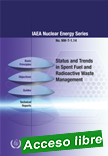 |
Status and Trends in Spent Fuel and Radioactive Waste Management
IAEA Nuclear Energy Series, 2018, 57 p.
Based on the outcome of a collaborative project undertaken by the IAEA, OECD-NEA and the European Commission, this publication provides a global overview of the status of radioactive waste and spent fuel management concerning inventories, programmes, current practices, technologies and trends. It includes an analysis of national arrangements and |
programmes for radioactive waste and spent fuel management, an overview of current waste and spent fuel inventories and estimates of future amounts. International and national trends in these areas are also addressed.
Extraído de: http://www-pub.iaea.org/books/IAEABooks/11173/Status-and-Trends-in-Spent-Fuel-and-Radioactive-Waste-Management |
 |
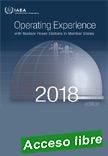 |
Operating Experience with Nuclear Power Stations in Member States in 2017 - 2018 Edition - Operating Experience with Nuclear Power Stations in Member States (CD-ROM)
IAEA, 2018, 1.580 p.
This CD-ROM contains the 49th edition of the IAEA’s series of annual reports on operating experience with nuclear power plants in Member States. It is a direct output from the IAEA’s Power Reactor Information System (PRIS). The dashboards of individual operational reactor units contain information on their
|
overall performance during 2017. In addition to annual information, the report contains a historical summary of performance during the lifetime of individual plants and figures illustrating worldwide performance of the nuclear industry.
Extraído de: https://www-pub.iaea.org/books/IAEABooks/13392/Operating-Experience-with-Nuclear-Power-Stations-in-Member-States-in-2017 |
 |
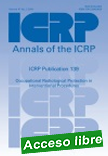 |
The concept of ‘effective dose’ (E) was developed by ICRP as a risk-adjusted dosimetric quantity for the management of protection against stochastic effects, principally cancer, enabling comparison of planned or received doses with dose limits, dose constraints, and reference levels expressed in the same quantity. Its use allows all radiation exposures 92
|
from external and internal sources to be considered together and summed, relying on the assumptions of a linear-non-threshold dose-response relationship, equivalence of acute and chronic exposures at low doses or low dose rates, and equivalence of external and internal exposures. Considering exposures incurred by patients during medical procedures, E is of practical value for comparing: doses from different diagnostic examinations and interventional procedures; the use of similar technologies and procedures in different hospitals and countries; and the use of different technologies for the same medical examination, provided that the representative patients or patient populations for which the effective doses are derived are similar with regard to age and sex. As stated in the 2007 Recommendations (ICRP, 2007a), “… risk assessment for medical diagnosis and treatment … is best evaluated using appropriate risk values for the individual tissues at risk and for the age and sex distribution of the individuals undergoing the medical procedures”. Publication 103 (ICRP, 2007a) provides detailed explanation of the purpose and use of E and of equivalent dose to individual organs and tissues. However, questions have arisen regarding practical applications, highlighting a clear need for further guidance on specific aspects. This publication draws on the explanations provided in Publication 103 and emphasises that E has proved a valuable and robust quantity for use in the optimisation of protection, to set dose criteria and verify compliance. Conclusions are drawn that: a) Equivalent dose (H) is not required as a protection quantity. It will be more appropriate for limits for the avoidance of tissue reactions for the hands and feet, lens of the eye, and skin, to be set in terms of absorbed dose (Gy) rather than equivalent dose (Sv). b) While risk assessments for individuals based on organ/tissue doses and specific dose-risk models make best use of scientific knowledge, E may be used as an approximate indicator of possible risk, recognising that this is a pragmatic, but unintended, application of effective dose. It is made clear in this report that while doses incurred at low levels of exposure may be measured or assessed with reasonable accuracy, the associated risks are increasingly uncertain at lower doses. However, bearing in mind the uncertainties associated with risk projection to low doses, E may be considered as an approximate indicator of possible risk, with the additional consideration of variation in risk with age, sex and population group. Use of E in this way is not a substitute for risk analysis using best estimates of organ/tissue doses, appropriate information on the relative effectiveness of different radiation types, and age-, sex- and population-specific risk factors, with consideration of uncertainties.
Extraído de: http://www.icrp.org/page.asp?id=382
|
 |
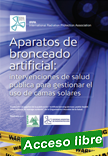 |
Aparatos de Bronceado Artificial: Intervenciones de Salud pública para Gestionar el Uso de Camas Solares
Organisación Mundial de la Salud/International Radiation Protection Association, 2018, 48 p.
El propósito de este documento es proporcionar información de ayuda para la introducción de intervenciones relacionadas con el uso y la gestión de las camas solares. El documento proporciona un resumen de los efectos sobre la salud, así como un catálogo de intervenciones que se han utilizado para |
reducir los riesgos asociados con el bronceado artificial. Se complementa con una base de datos de la OMS sobre las regulaciones para camas solares.
Extraído de: http://www.irpa.net/members/18119_Spanish Artificialtanning devices Public health interventions to manage sunbeds_For Web.pdf
|
 |
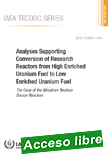
|
Analyses Supporting Conversion of Research Reactors from High Enriched Uranium Fuel to Low Enriched Uranium Fuel - The Case of the Miniature Neutron Source Reactors
IAEA TECDOC, 2018, 260 p.
This publication was developed based on the results of an IAEA coordinated research project (CRP) and will serve as a reference to those potentially involved in conversion of research reactors from high enriched uranium (HEU) to low enriched uranium (LEU). The publication contains |
comprehensive design and safety analyses for the conversion of miniature neutron source reactors (MNSRs) and includes analyses that were performed by MNSR operating organizations participating in the CRP using data specific to their MNSR. The outcome of this CRP can therefore be used to provide best practice guidelines in preparation for conversion of research reactors by individual research reactor operating organizations, and as a procedural and methodological reference for regulatory bodies and other stakeholders involved in the conversion of research reactors.
Extraído de: https://www-pub.iaea.org/books/IAEABooks/11064/Analyses-Supporting-Conversion-of-Research-Reactors-from-High-Enriched-Uranium-Fuel-to-Low-Enriched-Uranium-Fuel
|
 |
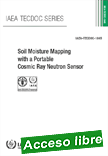 |
Soil Moisture Mapping with a Portable Cosmic Ray Neutron Sensor
IAEA TECDOC, 2018, 56 p.
This publication was developed as an informational guide for soil moisture mapping at landscape level through a portable ‘backpack’ cosmic-ray neutron sensor. This recently developed device monitors soil water content in a non-invasive way using background neutron counts.. It is used to measure water content in the topsoil over wide areas, covering approximately 20
|
hectares with one single measurement. Through its mobility and combining series of measurements, this provides the spatial variability of the soil water content for better agricultural water management. The publication provides scientists, technicians and students with the necessary information, guidance and steps to calibrate, validate and deploy this portable cosmic-ray neutron sensor.
Extraído de: https://www-pub.iaea.org/books/IAEABooks/12357/Soil-Moisture-Mapping-with-a-Portable-Cosmic-Ray-Neutron-Sensor |
 |
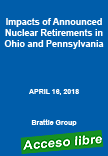 |
Impacts of Announced Nuclear Retirements in Ohio and Pennsylvania
Brattle Group, April 2018, 9 p.
Brattle Principals Dean Murphy and Mark Berkman have authored a report that estimates the environmental and electricity price impacts of the announced retirements of four nuclear plants in Ohio and Pennsylvania. The owners of the four plants announced that they will be retired over the next several years due to challenges in wholesale power markets
|
that do not value the environmental attributes provided by these plants.
The authors’ analysis, which draws from prior work that examined the impacts of the Ohio and Pennsylvania nuclear plants, estimates that if the four nuclear plants were to continue operation, their output would offset substantial fossil generation from gas and coal plants. They find that the retirements of these plants would: Lead to an increase of over 21 million metric tons of carbon dioxide (CO2) emissions annually, and tens of thousands of tons of criteria pollutants; Cause a loss of zero-emissions generation greater than the total amount of renewable generation in the entire PJM region, reversing the emissions benefits of 25 years of renewable investments; – Raise gross electricity costs for customers by approximately $400 million for Ohio, $285 million for Pennsylvania, and $1.5 billion across all of PJM (Pennsylvania-New Jersey-Maryland).
Extraído de: http://www.brattle.com/news-and-knowledge/news/report-by-brattle-economists-estimates-the-impacts-of-nuclear-retirements-in-ohio-and-pennsylvania |
 |
|
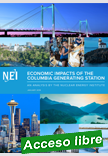
|
Economic Impacts of the Columbia Generating - An Analysis by the Nuclear Energy Institute
Nuclear Energy Institute (NEI - US), January 2018, 13 p.
The Columbia Generating Station (Columbia), located near Richland, Washington, has long been a vital part of the region’s energy portfolio, providing 100 percent carbon-free electricity since it began operating in 1984. In addition to this reliable, emission-free electricity, the plant supports hundreds of direct jobs. Employee involvement in their community also
|
makes Columbia a significant social and economic contributor to the state of Washington and the northwestern United States.
2018 total economic benefits for Washington include: $475 million in economic output from plant operations; $250 million increase in gross state product (GSP); $176 million in disposable personal income.
Extrído de: https://www.nei.org/resources/reports-briefs/economic-impacts-columbia-generating-station
|
 |
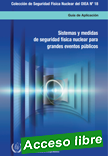 |
Sistemas y medidas de seguridad física nuclear para grandes eventos públicos
Colección de Seguridad Física Nuclear del OIEA, 2018, 76 p.
El propósito de la presente publicación es ofrecer una orientación estructurada a los Estados que puedan acoger un gran evento público. En ella se describen los sistemas y medidas de seguridad física nuclear que esos Estados pueden tener que establecer o aplicar para mejorar la eficacia y eficiencia de la seguridad física global del evento. La publicación
|
está destinada a los responsables de la formulación de políticas, los organizadores de los eventos, los organismos encargados de hacer cumplir la ley, los servicios de emergencia y las otras entidades responsables y de apoyo técnico pertinentes.
Extraído de: https://www-pub.iaea.org/MTCD/Publications/PDF/PUB1546_S_web.pdf
|
 |
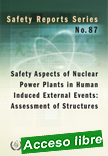 |
Safety Aspects of Nuclear Power Plants in Human Induced External Events: Assessment of Structures
IAEA Safety Reports Series, 2018, 204 p.
This publication provides detailed guidelines for the safety assessment of nuclear power structures against mechanical impact, explosion and fire caused by human induced external events. It covers the characterization of loading, the assessment of structural integrity using both simplified methods and more elaborated methodologies, and the
|
|

|
|
|
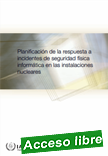 |
Planificación de la Respuesta a Incidentes de Seguridad Física Informática en las Instalaciones Nucleares
Colección de Seguridad Física Nuclear del OIEA, 2018, 80 p.
El propósito de la presente publicación es ayudar a los Estados Miembros a elaborar planes de
contingencia completos para los incidentes de seguridad física informática que puedan repercutir negativamente en la seguridad nuclear física y/o tecnológica. Esta publicación complementa la documentación ya existente al abordar el carácter especial
|
de los materiales nucleares y otros materiales radiactivos y los requisitos de seguridad física específicos para estos materiales. Ofrece orientaciones sobre los elementos clave para elaborar y aplicar una respuesta completa a un incidente de seguridad física informática (es decir, un ciberataque) que pueda comprometer o menoscabar la seguridad física nuclear. La
publicación abarca lo siguiente:
— la caracterización de los incidentes de seguridad física informática;
— la definición de la política de respuesta y de las funciones y las responsabilidades
correspondientes;
— la ejecución del Plan de Respuesta a Incidentes de Seguridad Física Informática;
— la comunicación de los incidentes de seguridad física informática;
— consideraciones relativas a los sistemas de control industrial;
— consideraciones relativas a los sistemas de información;
— consideraciones relativas a los sistemas de protección física;
— consideraciones relativas a la seguridad física nuclear.
Extraído de:https://www-pub.iaea.org/MTCD/Publications/PDF/TDL005_S_web.pdf
|
| |
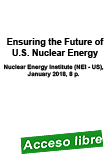 |
Ensuring the Future of U.S. Nuclear Energy
Nuclear Energy Institute (NEI - US), January 2018, 8 p.
New innovative U.S. technologies currently in design, development and licensing are setting a new standard for nuclear energy. However, this technology leadership is at risk. To ensure continued American leadership in global nuclear markets, the U.S. government should act promptly to create a streamlined and predictable licensing pathway for advanced reactors, thereby supporting innovation, commercialization and
|
deployment of new nuclear technologies.
To ensure that advanced reactors are licensed and built in the U.S., near-term regulatory reforms are necessary. These reforms should focus on achieving the following near-term objectives: Reversing the trend of increasing regulatory costs and excessively long reviews; Aligning the regulatory framework for advanced reactors with their inherent enhanced safety; Defining licensing options clearly, including options for staged applications and approval; Providing additional flexibility for changes during construction.
Extraído de:https://www.nei.org/resources/reports-briefs/ensuring-the-future-of-us-nuclear-energy
|
| |
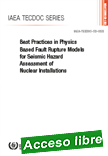 |
Best Practices in Physics Based Fault Rupture Models for Seismic Hazard Assessment of Nuclear Installations - Proceedings of a Workshop Held in Vienna, 18–20 November 2015
IAEA TECDOC (CD-ROM), 2018, s. p
These proceedings present the outcomes of a workshop convened by the IAEA in 2015. These proceedings present the outcomes of a workshop convened by the IAEA in 2015. The workshop brought together experts in seismology and
|
earthquake engineering to discuss the applicability of the so called physics-based fault rupture models to generate synthetic earthquake ground motion data for meaningful extrapolation of ground motion prediction in areas where there is a lack of sufficient observations. Fault rupture modelling is recommended for estimating strong motion in cases where nearby faults contribute significantly to the seismic hazard for nuclear installations. The overall aspects and process of the modelling and ground motion simulation are described in IAEA Safety Standards Series No. SSG-9, published in 2010. However, after the massive earthquake in Japan in 2011, there has been further progress in physics-based fault rupture modelling. Therefore, the IAEA arranged this workshop and the publication arising from it. The intention is to provide practical, up-to-date guidance contributing to effective seismic hazard analysis.
Extraído de:http://www-pub.iaea.org/books/IAEABooks/12273/Best-Practices-in-Physics-Based-Fault-Rupture-Models-for-Seismic-Hazard-Assessment-of-Nuclear-Installations
|
| |
| |
|
|
|
